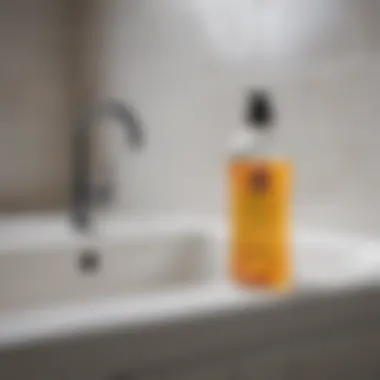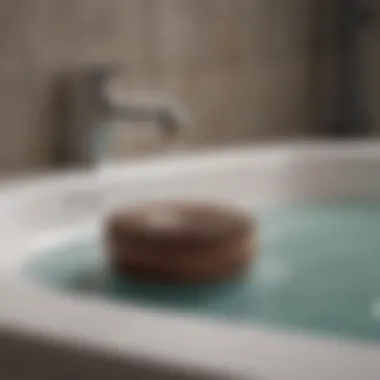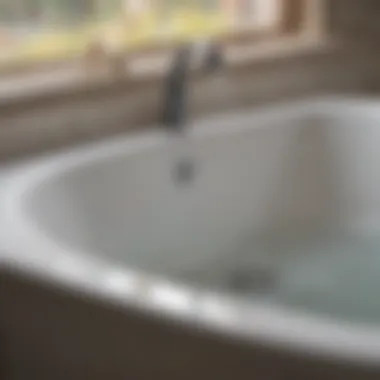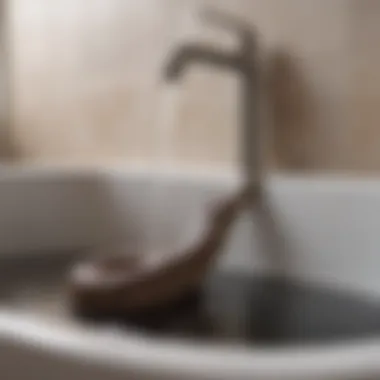Effective Methods to Remove Hair Clogs from Your Bathtub Drain


Hair clogs in a bathtub drain can be a nuisance, causing slow drainage and potential plumbing issues. In this comprehensive guide, we will explore effective methods to tackle this common problem, from using simple tools to environmentally friendly solutions. By following these steps, you can maintain a clear drain and avoid costly repairs.
Common Tools for Hair Clog Removal
When faced with a stubborn hair clog in your bathtub drain, having the right tools on hand is essential. A pair of sturdy gloves, a drain snake, and a plunger are invaluable in dislodging and removing trapped hair. These tools are easily obtainable and user-friendly, making the clog removal process more manageable and efficient.
Eco-Friendly Solutions for Clear Drains
For those environmentally conscious individuals, there are eco-friendly alternatives to harsh chemical drain cleaners. White vinegar and baking soda, when combined, create a powerful fizzing reaction that can break down hair clogs effectively. Additionally, using a drain hair catcher regularly can prevent clogs from forming in the first place, reducing the need for harsh chemicals and promoting sustainable drain maintenance practices.
Importance of Regular Drain Maintenance
Prevention is key when it comes to keeping your bathtub drain clear of hair clogs. By incorporating regular drain maintenance into your cleaning routine, such as monthly cleanings with baking soda and vinegar, you can proactively prevent clogs from disrupting your plumbing system. This simple but effective practice can save you time and money in the long run, ensuring smooth drainage and a hassle-free bathing experience.
Summary
Introduction
In the realm of domestic nuisances, dealing with pesky hair clogs in the bathtub drain is a common struggle that many individuals encounter. This article serves as a comprehensive guide on effectively removing these stubborn blockages, providing invaluable insights on the tools and methods necessary to maintain a smoothly functioning drainage system.
Understanding the Issue
Why Hair Clogs Drain
Hair clogging drains is primarily attributed to the shedding of hair during bathing routines. The accumulation of hair down the drain leads to blockages that impede the smooth flow of water. Understanding why hair clogs drain is crucial for implementing effective removal strategies. Despite being a common occurrence, hair clogs can significantly disrupt the drainage system if not promptly addressed. Implementing proactive measures to tackle hair clogs is vital in maintaining optimal plumbing functionality.
Impact on Drainage System
The impact of hair clogs on the drainage system is profound, affecting the efficiency of water flow and drainage performance. Clogged drains often result in slow drainage rates and water pooling, indicating the urgency of unclogging interventions. Addressing these issues promptly is essential to prevent further damage to the plumbing system and avoid costly repairs. Recognizing the impact of hair clogs on the drainage system underscores the importance of routine maintenance and proactive measures to safeguard the overall health of the plumbing infrastructure.
Signs of a Hair Clogged Drain
Slow Drainage
One of the notable signs of a hair-clogged drain is slow drainage, where water struggles to flow smoothly down the pipes. This sluggish drainage is indicative of a blockage hindering the water's passage, typically caused by accumulated hair and debris. Acting promptly upon noticing slow drainage can prevent more severe plumbing complications and restore optimal water flow within the plumbing system.
Pooling Water
Pooling water around the drain area is another common sign of a hair-clogged drain. The accumulation of water due to blocked drainage signifies the presence of a clog that requires immediate attention. Pooling water not only indicates a disruption in the drainage system but also poses hygiene concerns and potential water damage risks. Addressing pooling water promptly is essential to prevent further complications and maintain a functional plumbing system.
Tools Needed


When it comes to addressing hair clogs in your bathtub drain, having the right tools at your disposal is crucial. These tools play a vital role in effectively removing blockages and restoring proper drainage in your plumbing system.
Basic Tools
In the realm of basic tools for dealing with hair clogs, two essentials stand out: the plunger and the wire hanger.
Plunger
The plunger is a fundamental tool for clearing blockages in drains, including those caused by hair clogs. Its design creates suction and pressure, which helps dislodge and push out trapped debris. One of the key characteristics of a plunger is its versatility, making it suitable for various types of drain obstructions. Its simplicity and effectiveness make it a popular choice for homeowners seeking a DIY solution for their clogged bathtub drains.
Advantages
The primary advantage of using a plunger is its ease of use. With a few simple plunges, you can often clear minor hair clogs without the need for harsh chemicals or professional assistance. Additionally, plungers are affordable, readily available at most hardware stores, and are reusable for future clogs.
Disadvantages
While effective for minor blockages, plungers may struggle with particularly stubborn or deep-seated clogs. In such cases, more advanced tools like a plumbing snake may be necessary.
Wire Hanger
A wire hanger is another basic tool that can be repurposed for tackling hair clogs in drains. By straightening out the hanger and creating a small hook at one end, you can maneuver it into the drain to hook and pull out trapped hair and debris.
Advantages
The main advantage of using a wire hanger is its accessibility. Most households have wire hangers on hand, making it a convenient and cost-effective alternative to purchasing specialized tools. Additionally, the flexibility of the hanger allows for maneuvering around curves and obstacles in the drain.
Disadvantages
One potential disadvantage of using a wire hanger is the risk of causing damage to the drain pipes if not used carefully. The sharp edges of the wire can scratch or puncture the pipe lining if excessive force is applied.
Advanced Tools
For more challenging hair clogs that cannot be cleared by basic methods, advanced tools such as the plumbing snake and drain claw come into play.
Plumbing Snake
A plumbing snake, also known as an auger, is a flexible tool designed to navigate through drains and break up obstructions like hair clogs. Its key characteristic lies in its ability to reach deep into the drain pipe, dislodging and removing tough blockages.
Advantages
The primary advantage of a plumbing snake is its reach and effectiveness in addressing clogs located further down the drain. It can tackle complex blockages that basic tools may struggle to dislodge, making it a valuable asset for more severe drainage issues.


Disadvantages
One drawback of using a plumbing snake is the potential risk of causing damage to older or fragile pipes. The force exerted by the snake during operation can put strain on pipe joints or dislodge connections if not used cautiously.
Drain Claw
A drain claw is a specialized tool designed to grab and extract hair and debris from drains. With its claw-like features, it can latch onto clogs and pull them out, akin to a grabber tool.
Advantages
The unique feature of a drain claw is its ability to grasp onto hair clogs firmly, allowing for quick and efficient removal. Its design prevents further pushing of the clog deeper into the pipe, reducing the risk of worsening the blockage.
Disadvantages
One limitation of a drain claw is its restricted range of motion compared to a plumbing snake. While effective for clogs near the surface, it may not reach deep-seated blockages within the drain.
DIY Methods for Hair Clog Removal
In this section, we will delve deep into the vital aspect of DIY methods for efficiently tackling hair clogs within your bathtub drain. Emphasizing the significance of this topic in our article, we aim to equip you with the knowledge and techniques necessary to address this common issue promptly and effectively. By focusing on the DIY approach, we empower readers to take control of their plumbing maintenance, saving both time and money in the process. Furthermore, DIY methods offer environmentally friendly alternatives to harsh chemical products prevalent in conventional drain cleaners, aligning with the theme of our guide's eco-conscious solutions.
Homemade Solutions
Vinegar and Baking Soda
Exploring the effectiveness of vinegar and baking soda in combating hair clogs, we recognize their dual-action formula as a standout solution for drain maintenance. The foaming reaction generated by combining these household staples serves to dislodge and break down hair accumulations, facilitating easier removal when flushed with hot water. This affordable and readily available mixture stands out for its gentle yet potent cleaning properties, making it a popular choice for environmentally conscious individuals seeking to avoid abrasive chemicals while maintaining their plumbing system.
Hot Water and Salt
Turning our attention to the combination of hot water and salt, we uncover a simple yet effective remedy for hair clogs affecting your bathtub drain. The heat from boiling water aids in loosening the hair mass, while the abrasive nature of salt contributes to breaking down the blockage for improved drainage. This natural solution not only offers a sustainable alternative to commercial drain cleaners but also eliminates the need for potentially harmful substances that may impact your plumbing system adversely. By outlining the advantages and disadvantages of this method, readers can make informed decisions tailored to their specific needs and preferences.
Natural Drain Cleaners
Enzymatic Drain Cleaners
Diving into the realm of enzymatic drain cleaners, we explore a bio-friendly approach to combating hair clogs within your plumbing system. Harnessing the power of enzymes to target organic matter like hair, these cleaners offer a non-toxic and sustainable solution for maintaining clear drains. The enzymatic action breaks down hair and other debris, preventing future blockages and promoting a healthy drainage system. While highlighting the benefits of using enzymatic cleaners, we also address any potential drawbacks, ensuring a comprehensive overview of this natural alternative.
Citrus-Based Cleaners
In this segment, we shed light on citrus-based cleaners and their role in effectively managing hair clogs in your bathtub drain. Leveraging the natural properties of citrus extracts, these cleaners provide a fragrant and eco-conscious way to tackle plumbing issues without harsh chemicals. The acidic nature of citrus oils helps dissolve hair blockages, leaving behind a fresh scent and clear drainage. By outlining the unique features and considerations associated with citrus-based cleaners, readers can explore a viable option that aligns with their preference for environmentally friendly solutions, marking a pivotal step towards sustainable drain maintenance.
Preventive Measures


When it comes to maintaining a clear bathtub drain, preventive measures play a crucial role in averting hair clogs and potential plumbing dilemmas. By incorporating preventive strategies, homeowners can prolong the lifespan of their drainage system and prevent the inconvenience of dealing with stubborn blockages. Regular preventive measures not only ensure the efficient flow of water but also save both time and money that would otherwise be spent on repairs. Hair catchers and proactive maintenance practices are integral components of preventive measures that contribute significantly to the overall health of your bathtub drain.
Hair Catchers
Hair catchers are essential devices designed to trap hair and prevent it from entering the drain, thus reducing the risk of clogs. Different types of hair catchers are available in the market, each offering specific features and benefits. From basic mesh strainers to advanced designs with silicone edges, choosing the right hair catcher depends on individual preferences and drainage requirements. Opting for a high-quality hair catcher ensures efficient hair removal while allowing water to flow seamlessly through the drain. These devices are popular choices among homeowners looking to mitigate the impact of hair clogs and maintain a clear drain.
Types of Hair Catchers
Types of hair catchers include mesh strainers, pop-up stoppers, and silicone designs, each catering to distinct needs and preferences. Mesh strainers effectively capture hair before it enters the drain, preventing blockages and minimizing the need for frequent cleaning. Pop-up stoppers combine functionality with aesthetics, offering a convenient way to prevent hair buildup in the drain. Silicone hair catchers feature flexible construction that ensures a snug fit in various drain sizes, enhancing their versatility and efficiency in trapping hair.
Installation Tips
Installing a hair catcher is a simple yet effective method to safeguard your bathtub drain from hair clogs. To install a hair catcher, begin by removing any existing stopper or debris from the drain. Ensure the hair catcher fits securely over the drain opening, creating a tight seal to capture hair effectively. Regularly clean and empty the hair catcher to maintain its efficiency and prevent restricted water flow. By following proper installation techniques, homeowners can enhance the functionality of their hair catcher and prolong its lifespan, reducing the frequency of clogs and drain-related issues.
Regular Maintenance
In addition to using hair catchers, implementing a regular maintenance regimen is essential for keeping your bathtub drain clear and free from obstructions. Weekly cleaning routines and periodic professional maintenance services are key practices that contribute to the longevity and efficiency of your drainage system. By adhering to a structured maintenance schedule, homeowners can proactively address potential clogging issues and ensure optimal drain performance.
Weekly Cleaning Regimen
A weekly cleaning regimen involves clearing out any debris, soap scum, or hair accumulation in the drain to prevent blockages. Using a plumbing snake or a mixture of baking soda and vinegar can help dislodge minor clogs and keep the drain flowing smoothly. Regularly flushing hot water down the drain can help dissolve grease and soap residue, maintaining clear passage for water to evacuate. Implementing these simple yet effective cleaning techniques on a weekly basis can prevent the buildup of materials that contribute to clogs and ensure the continuous functionality of your drain system.
Professional Maintenance
Sometimes, professional maintenance may be necessary to address persistent clogs or underlying plumbing issues within the drainage system. Calling a certified plumber for expert inspection and maintenance can help identify hidden problems and provide lasting solutions to recurring drain blockages. Professional maintenance services range from sewer line inspections using camera technology to hydro jetting for thorough drain cleaning. By investing in professional maintenance when needed, homeowners can alleviate more complex drainage issues and maintain a clear and efficient bathtub drain.
Professional Help
When it comes to addressing hair clogs in your bathtub drain, sometimes DIY methods may not suffice, and that's where professional help becomes crucial. Calling a plumber can provide expert assistance in dealing with persistently stubborn clogs or identifying underlying plumbing issues that DIY solutions cannot rectify. Before tackling such complex problems, it's essential to recognize the limitations of home remedies and acknowledge the value of professional intervention.
When to Call a Plumber
Persistent Clogs
Persistent clogs pose a significant challenge in drain maintenance due to their stubborn nature. These clogs resist typical removal techniques and require advanced tools and expertise for effective clearance. Persistent clogs can indicate a more severe underlying issue within the drainage system, demanding professional assessment and resolution. Their resilience to conventional methods necessitates professional intervention to prevent further damage and ensure lasting results. Engaging a plumber for persistent clogs guarantees a thorough inspection and tailored solution to restore optimal drainage functionality.
Underlying Plumbing Issues
Underlying plumbing issues encompass a range of complexities that contribute to persistent clogs and diminish drain performance. These issues often stem from structural faults, pipe damage, or improper installation, requiring specialized skills to diagnose and correct. Addressing underlying plumbing problems demands professional knowledge and equipment to ensure comprehensive repair and prevent recurring clogs. By entrusting these issues to a qualified plumber, you prioritize long-term drainage efficacy and mitigate the risk of extensive damage or system failure. Their expertise in resolving intricate plumbing concerns safeguards the integrity of your drainage system and promotes sustainable functionality.
Conclusion
Maintaining a clear drain is vital for the smooth functioning of your bathtub. By following the preventive measures and DIY methods discussed in this article, you can ensure that hair clogs are a thing of the past. Addressing clogs promptly can prevent more extensive plumbing issues down the line, saving you time and money in the long run. Remember, a little regular maintenance can go a long way in keeping your drainage system in top condition.
Maintaining a Clear Drain
Key Takeaways
When it comes to maintaining a clear drain, the key takeaways from this article are crucial. One of the essential aspects is the importance of installing hair catchers in your bathtub drain. These simple devices effectively trap hair and prevent it from accumulating in your pipes, reducing the chances of clogs. Another key takeaway is adopting a regular cleaning regimen. By implementing a weekly cleaning routine using natural drain cleaners like vinegar and baking soda, you can proactively prevent clogs from forming. These eco-friendly solutions are not only effective but also gentle on your plumbing system, promoting longevity.



